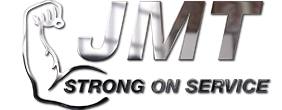Fiber Lasers – How They Run
JMT offers a complete line of fiber lasers to our fabrication customers. JMT developed this fiber laser system in a fully operational cutting house, which allowed every aspect of the laser to be optimized for maximum output at minimal cost and maintenance. Their R&D department is the world’s largest fiber laser job shop, where ten lasers are in production around the clock, seven days a week, cutting parts for actual customers.
In order to understand how this type of laser cutting system differs from CO2 lasers and plasma cutting systems, here is some information about how fiber lasers run.
JMT fiber lasers require nearly 1/3 the power that CO2 laser cutting systems require and operate at half the total cost. This laser system can also run on either nitrogen or oxygen, rather than limiting you to one gas. This is considerable advantage to other laser cutting systems that rely on just one type of gas which could severely increase your operating costs during times of shortages and high demand.
The JMT fiber laser is capable of cutting a wide variety of metals at various gauges. For thin metals, the fiber laser can cut up to 2x the speed of other cutting systems with increased accuracy. A 4KW JMT fiber laser can cut up to 20mm sheet metal depending on the type of material.
The fiber laser utilizes a fiber cable that is virtually self-cooling, reducing the need for excessive cooling measures. This also decreases the amount of maintenance needed while increasing the life of the cable. The fiber laser offers a 100,000 hour diode life and is operational 24/7 without excessive warm-up and cool-down times. The efficiency of the fiber laser contributes to the minimal maintenance required. There are no parts to change or routine maintenance to be completed that would affect production.
Call JMT today to discover how implementing a fiber laser in your shop will reduce your energy usage and operating costs while increasing productivity and accuracy.

